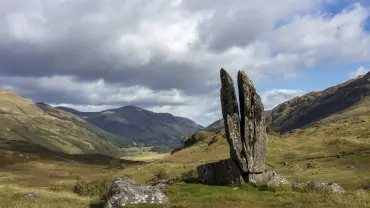There isn’t a single photograph confirming their existence, nor a single person alive who can confirm they are real or claiming to have seen them, but that doesn’t stop the legend of the Dropa discs captivating the minds of archeologists, historians, and extraterrestrial enthusiasts alike. Purportedly discovered in a series of interlinked caves in the mountains of Bayan Har in 1938, the curious disc-shaped Dropa stones have become an emblem of controversy and fascination.
At the core of this mystery lies the rather fanciful story of the Dropa aliens, a supposedly indigenous people from a planet in the Sirius constellation who are said to have crashed in northwestern China around 12,000 years ago. The 1938 expedition is alleged to have found their graves, as well as 716 granite discs recounting the crash.
The legend of the Dropa stones – sometimes known as the Bayan Har stones – is somewhere between urban myth and pseudoarchaeology. If taken at face value, it would dramatically alter our understanding of ancient human history and our place in the cosmos. For many who believe the story, the notion of coming into contact with extraterrestrial beings is undeniably captivating.
However, like many legends of antiquity, concrete evidence supporting the existence and authenticity of the Dropa discs is non-existent. The original artefacts are nowhere to be found, and almost all details about their discovery and subsequent analysis seem to blend folklore and unsubstantiated fact in uncertain proportions.
Let’s go back in time to try and shed light on this scarcely-believable enigma.
The Discovery of the Dropa Stones
The legend of the Dropa granite stones is shrouded in mystery, and there’s significant controversy regarding the details. Due to the mix of fact and fiction surrounding the story, creating a detailed account is challenging.
As the story has been told and retold so many times – and translated from a number of different languages – embellishments added each time make their way into the narrative. The most often-told version of the story starts with a Chinese professor or archaeologist named Dr Chi Pu Tei, of whom no clear evidence actually exists.
To add a further layer of mystery to this story, the earliest published version of the tale of the Dropa stones is supposed to have appeared, somewhat bizarrely, in a magazine for German vegetarians in 1962 written by Reinhardt Wegemann, however no writer by this name has ever been found.
Dr Chi Pu Tei is supposed to have found a series of interlinked caves, or hand-carved tunnels according to some interpretations, which contained the perfectly aligned graves of ancient, extraterrestrial skeletons, just over a metre in height with elongated limbs, short bodies and very large heads. It may be a coincidence, but the science fiction magazines of the 1930s depicted visitors from outer space with exactly these characteristics.
Alongside these graves were 716 granite discs claimed to be around thirty centimetres in diameter, now known as the Dropa stones. Each disc was supposedly carved with tiny hieroglyphics, said to tell the story of the crash. One was reported to have said—
The Dropa came down from the clouds in their aircraft. Our men, women and children hid in the caves ten times before sunrise. When at last we understood the sign language of the Dropas, we realised that the newcomers had peaceful intentions.
As the story goes, sometime between the late 1930s and the early 1960s, the Dropa discs came into the possession of a man named Tsum Um Nui from either the Beijing Academy for Ancient Studies or the Academy of Prehistory in Beijing (neither of which exist). He is said to have published the story in an academic periodical but was met with ridicule. In the unlikely event he exists, the story suggests he was then exiled to Japan, possibly in the late 1960s, where he’s said to have died shortly after.
Where are the Dropa Bayan Har Stones?
Put simply, no-one knows. There’s no evidence they have ever existed. Not a single photograph exists and there’s no concrete evidence of anyone seeing or touching one. The story was republished in 1966 in a Russian magazine by a reporter believed to be called Vyacheslav Zaitsev who stated the Dropa granite stones were shipped to Russia for examination.

Read More About: Mysteries
What is the Kensington Runestone and is it Real?
It was said that while in Russia, the discs were found to be highly metallic and may have been electrically charged. Again, no evidence exists to suggest this was the case.
In 1974, an Austrian engineer called Ernst Wegerer (or Wegener) claimed he photographed two of the stones made by the Dropa aliens in the Banpo Museum in Shaanxi Province, but the images were apparently too grainy to make out any of the hieroglyphics and the flash obscured any detail. Once again, these images have never come to light and remain part of the mystery.
Are They Bì Discs?

A Bì disc from the Western Han dynasty (Photo by Heritage Art/Heritage Images via Getty Images)
The description of the Dropa stones – circular discs with a hole in the centre – does bear resemblance to the ancient Chinese bì discs. These discs are ritual jade objects that have been found in a number of Neolithic archaeological sites in China. They date from the late Neolithic period to the Shang dynasty, and while their exact purpose and meaning remain somewhat mysterious, they’re often associated with the heavens, ritual ceremonies, or high-status burials. Over time, they became symbols of wealth and power.
Given the resemblance in description, it’s conceivable that any real stone discs found might have been misinterpreted or misconstrued as the more sensational Dropa discs, especially if taken out of their original archaeological context and infused with unsubstantiated narratives. This is speculative, of course, but it’s not uncommon for genuine artefacts to be misinterpreted or repurposed to fit alternative or fringe theories.
Into the Unknown: Navigating the Truth of the Dropa Stones
The legend of the Dropa stones continues to provoke, puzzle, and captivate. From the depths of ancient tombs to the far reaches of the cosmos, the tale meanders through a maze of unverifiable fact, fantastic fiction, and fervent belief.
Must Read
While it’s tempting to get lost in the romanticism of such tales, without verified evidence of the Dropa aliens, drawing any definitive conclusions remains a challenge. Whatever the truth behind these mysterious discs may be, whether they depict an ancient encounter with visitors from the stars or are simply a figment of cultural storytelling, their story, real or imagined, remains an intriguing blend of folklore, speculation, and mystery.












